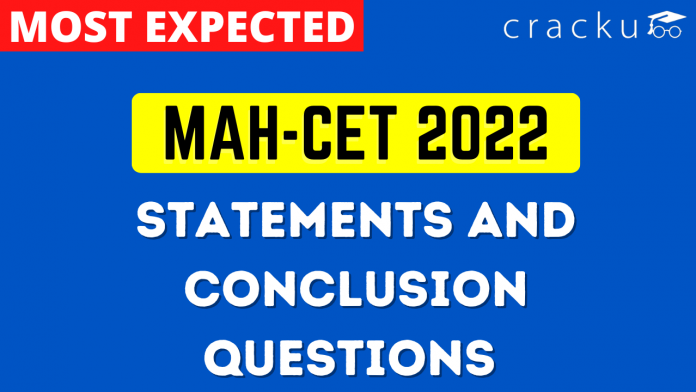Statements and Conclusion Questions for MAH-CET
Here you can download a free Statements and Conclusion questions PDF with answers for MAH MBA CET 2022 by Cracku. These are some tricky questions in the MAH MBA CET 2022 exam that you need to find the Statements and Conclusion of answers for the given questions. These questions will help you to make practice and solve the Statements and Conclusion questions in the MAH MBA CET exam. Utilize this best PDF practice set which is included answers in detail. Click on the below link to download the Statements and Conclusion MCQ PDF for MBA-CET 2022 for free.
Download Statements and Conclusion Questions for MAH-CET
Enroll to MAH-CET 2022 Crash Course
Instructions
In these questions, relationship between dif erent elements is shown in the statements. The statements are followed by conclusions. Study the conclusions based on the given statements and select the appropriate answer. Give answer:
a: If only conclusion I is true
b: If either conclusion I or II is true
c: If only conclusion II is true
d: If neither conclusion I nor II is true
e: If both conclusions I and II are true
Question 1: Statements : J > U ≥ M > P; U $\leq$ N > R
Conclusion :
I. M ≤ N
II. J > R
a) If only conclusion I is true
b) If either conclusion I or II is true
c) If only conclusion II is true
d) If neither conclusion I nor II is true
e) If both conclusions I and II are true
1) Answer (A)
Solution:
1) M $\leq$ N : We know that M $\leq$ U $\leq$ N. Hence, we can say that M is less than or equal to N. Conclusion I follows.
2) J > R : We know that J > U $\leq$ N > R. Here the relationship between U and N cannot be made and hence the relationship between J and R cannot be made. Hence, conclusion II does not follow.
Hence, option A is the correct answer.
Instructions
In these questions, a relationship between dif erent elements is shown in the statements. The statements are followed by two conclusions. Give answer :
a:If only conclusion I is true
b: If only conclusion II is true
c: If either conclusion I or II is true
d: If neither conclusion I nor II is true
e: If both conclusions I and II are true
Question 2: Statements : A>B>C<D, C= E>G
Conclusions :
I. D > E
II. B > E
a) If only conclusion I is true
b) If only conclusion II is true
c) If either conclusion I or II is true
d) If neither conclusion I nor II is true
e) If both conclusions I and II are true
2) Answer (E)
Solution:
1) D > E : D is greater than C and C is equal to E. Hence, conclusion I follows
2) B > E : B is greater than C and C is equal to E. Hence, Conclusion II follows.
Hence, option e is the correct answer.
Instructions
In these questions, relationship between different elements is shown in the statements. The statements are followed by two conclusions. Study the conclusions based on the given statements and select the appropriate answer.
Give answer :
a:If either conclusion I or II is true
b: If both conclusions I and II are true
c: If only conclusion I is true
d: If only conclusion II is true
e: If neither conclusion I nor II is true
Question 3: Statements :
C < O ≤ Z ≥ Y ; N > Z < M
Conclusions :
I. C < N
II. O > M
a) If either conclusion I or II is true
b) If both conclusions I and II are true
c) If only conclusion I is true
d) If only conclusion II is true
e) If neither conclusion I nor II is true
3) Answer (C)
Solution:
C is less than Z and N is greater than Z. Therefore, C is definitely less than Z. Conclusion I is true.
M is greater than Z. Z is greater than or equal to O. Therefore, M is definitely greater than O. Conclusion II states that M is less than O. Therefore, conclusion II is definitely false.
Only conclusion I is true. Therefore, option C is the correct answer.
Instructions
In these questions, relationship between different elements is shown in the statements. The statements are followed by conclusions. Study the conclusions based on the given statements and select the appropriate answer.
Give answer :
a: Both conclusions I and II are true
b: Only conclusion I is true
c: Neither conclusion I nor II is true
d: Only conclusion II is true
e: Either conclusion II or conclusion is true
Question 4: Statements : $S<M<I<T; R \geq J > I$
Conclusions :
I. $R = S$
II. $S < R$
a) Both conclusions I and II are true
b) Only conclusion I is true
c) Neither conclusion I nor II is true
d) Only conclusion II is true
e) Either conclusion II or conclusion is true
4) Answer (D)
Solution:
$R$ is definitely greater than $I$. $S$ is definitely less than $I$.
Therefore, $S$ is less than $R$.
Only conclusion II is true. Therefore, option D is the right answer.
Instructions
In these questions, relationship between different elements is shown in the statements. The statements are followed by two conclusions. Study the conclusions based on the given statements and select the appropriate answer.
Give answer :
a: If either conclusion I or II is true
b: If both conclusions I and II are true
c: If only conclusion I is true
d: If only conclusion II is true
e: If neither conclusion I nor II is true
Question 5: Statements :
T > I ≥ L > E ; I ≤ N< B ; N ≥ S > D
Conclusions :
I. S ≤ I
II. L > D
a) If either conclusion I or II is true
b) If both conclusions I and II are true
c) If only conclusion I is true
d) If only conclusion II is true
e) If neither conclusion I nor II is true
5) Answer (E)
Solution:
We cannot get any direct relationship between S and I or L and D. Hence, neither of the two conclusions follows.
Take Free MAH-CET mock tests here
Enrol to 5 MAH CET Latest Mocks For Just Rs. 299
Instructions
In these questions, the relationship between different elements is shown in the statements. Two conclusions follow the statements. Study the conclusions based on the statement and select the appropriate answer. Give answer :
a: If either conclusion I or II is true
b: If both conclusions I and II are true
c: If only conclusion I is true
d: If only conclusion II is true
e: If neither conclusion I nor II is true
Question 6: Statements :I > A ≥ N ≥ T;
C ≤ I ≤ E
Conclusions :
I. A ≤ E
II. I ≥ N
a) If either conclusion I or II is true
b) If both conclusions I and II are true
c) If only conclusion I is true
d) If only conclusion II is true
e) If neither conclusion I nor II is true
6) Answer (E)
Solution:
Consider the given statements:
I > A ≥ N ≥ T; C ≤ I ≤ E
I is greater than A and E is greater than or equal to I. Hence, E is definitely greater than A. Hence, I is not definitely true. II is also not defnitely not true. Hence, option E is the correct answer.
Instructions
In each of the following questions, relationship between the different elements is shown in the statements. The statements are followed by two Conclusions numbered I and II. Study the Conclusions based on the given statements and mark the appropriate answer :
Give answer a: if both the Conclusion I and Conclusion II are true
Give answer b: if either Conclusion I or Conclusion II is true
Give answer c: if neither Conclusion I nor Conclusion II is true
Give answer d: if only Conclusion I is true
Give answer e: if only Conclusion II is true
Question 7: Statements
B < L < A = M > E ≥ S;
L > W > J
Conclusions :
I. J < M
II. J = M
a) if both the Conclusion I and Conclusion II are true
b) if either ConclUsion I or Conclusion II is true
c) if neither Conclusion I nor Conclusion II is true
d) if only Conclusion I is true
e) if only Conclusion II is true
7) Answer (D)
Solution:
From the given statements,
L > J and M > L. Hence, we can conclude that M > J. Only I is true.
Hence, option D is the correct answer.
Question 8: Statements:
C<R<E<A=M
Y>E
Conclusions:
I. C =Y
II. C < Y
a) if both the Conclusion I and Conclusion II are true
b) if either ConclUsion I or Conclusion II is true
c) if neither Conclusion I nor Conclusion II is true
d) if only Conclusion I is true
e) if only Conclusion II is true
8) Answer (E)
Solution:
We see that C < E and E < Y. Thus, C < Y. Thus conclusion II follows.
Question 9: Statements
C<R<E<A=M;Y>E
Conclusions :
I. M > R
II. Y > A
a) if both the Conclusion I and Conclusion II are true
b) if either ConclUsion I or Conclusion II is true
c) if neither Conclusion I nor Conclusion II is true
d) if only Conclusion I is true
e) if only Conclusion II is true
9) Answer (D)
Solution:
C<R<E<A=M;Y>E
From this statement, we can see that M is greater than R. Hence, conclusion I is true.
Now Y > E and A > E. Hence, we cannot compare A and Y. Thus, II is not valid.
Instructions
In each of the following questions relationship between
different elements is shown in the statements. The statements are followed by two
Conclusions numbered I and II. Study the Conclusions based on the given
statements and select the appropriate answer.
a: if only Conclusion II is true
b: if only Conclusion I is true
c: if both the Conclusion I and Conclusion II are true
d: if either Conclusion I or Conclusion II is true
e: if neither Conclusion I nor Conclusion II is true
Question 10: Statements :
A>B>C$\leq{D}\leq{E}$<F
Conclusions :
I. A> E
H. C < F
a) if only Conclusion II is true
b) if only Conclusion I is true
c) if both the Conclusion I and Conclusion II are true
d) if either Conclusion I or Conclusion II is true
e) if neither Conclusion I nor Conclusion II is true
10) Answer (A)
Solution:
Given statement is A>B>C$\leq{D}\leq{E}$<F
Thus, we can say that A>B>C and F>E$\geq{D}\geq{C}$
Thus we cannot find relation between A and E. Hence I is not true.
We can definitely say that F>C. Hence II is true.
Hence, option A is the right choice.





